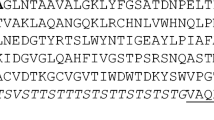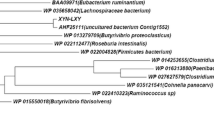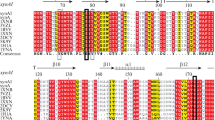Abstract
A pH-stable and protease-resistant xylanase (XynB119) was identified from Streptomyces sp. TN119, a strain isolated from the gut luminal contents of longhorned beetle (Batocera horsfieldi) larvae. Using the GC TAIL-PCR method, the 1,026-bp coding gene (xynB119) with 67.3% GC content was successfully cloned and expressed in Escherichia coli. It encodes a 341-residue polypeptide with a calculated molecular mass of 35.9 kDa, including a putative 41-residue signal peptide, a catalytic domain of glycosyl hydrolase (GH) family 11, a short Gly/Pro-rich linker, and a family 2 cellulose-binding domain (CBM 2). The deduced amino acid sequence is most similar to (61.9% identity) an endo-1,4-β-xylanase from Streptomyces thermoviolaceus OPC-520. Purified recombinant XynB119 exhibited peak activity at 50°C and pH 7.0, remained stable over a broad pH range (retaining >70% activity after incubation at pH 1.0–11.0 for 1 h at 37°C without substrate), had strong protease resistance (retaining >90% activity after proteolytic treatment at 37°C for 1 h) and SDS resistance (at 100 mM). These properties make XynB119 promising for application in the feed industry and valuable for basic research. Compared to r-XynB119, the r-XynB119 derivative without CBM 2 and linker region (r-XynB119d) exhibited a decreased pH stability of >25% at extreme pHs (pH 1.0–3.0 and pH 11.0–12.0).




Similar content being viewed by others
References
Thomson JA (1993) Molecular biology of xylan degradation. FEMS Microbiol Rev 104:65–82
Finn RD, Tate J, Mistry J, Coggill PC, Sammut SJ, Hotz HR, Ceric G, Forslund K, Eddy SR, Sonnhammer ELL, Bateman A (2008) The Pfam protein families database. Nucleic Acids Res 36:D281–D288
Collins T, Gerday C, Feller G (2005) Xylanases, xylanase families and extremophilic xylanases. FEMS Microbiol Rev 29:3–23
Scriber JM, Slansky F (1981) The nutritional ecology of immature insects. Annu Rev Entomol 26:183–211
Warnecke F, Luginbuhl P, Ivanova N, Ghassemian M, Richardson TH, Stege JT, Cayouette M, McHardy AC, Djordjevic G, Aboushadi N, Sorek R, Tringe SG, Podar M, Martin HG, Kunin V, Dalevi D, Madejska J, Kirton E, Platt D, Szeto E, Salamov A, Barry K, Mikhailova N, Kyrpides NC, Matson EG, Ottesen EA, Zhang XN, Hernandez M, Murillo C, Acosta LG, Rigoutsos I, Tamayo G, Green BD, Chang C, Rubin EM, Mathur EJ, Robertson DE, Hugenholtz P, Leadbetter JR (2007) Metagenomic and functional analysis of hindgut microbiota of a wood-feeding higher termite. Nature 450:560–565
Xu J, Mahowald MA, Ley RE, Lozupone CA, Hamady M, Martens EC, Henrissat B, Coutinho PM, Minx P, Latreille P, Cordum H, Van Brunt A, Kim K, Fulton RS, Fulton LA, Clifton SW, Wilson RK, Knight RD, Gordon JI (2007) Evolution of symbiotic bacteria in the distal human intestine. PLoS Biol 5:1574–1586
Ferrer M, Golyshina OV, Chernikova TN, Khachane AN, Reyes-Duarte D, Dos Santos V, Strompl C, Elborough K, Jarvis G, Neef A, Yakimov MM, Timmis KN, Golyshin PN (2005) Novel hydrolase diversity retrieved from a metagenome library of bovine rumen microflora. Environ Microbiol 7:1996–2010
Breznak JA, Brune A (1994) Role of microorganisms in the digestion of lignocellulose by termites. Annu Rev Entomol 39:453–487
Zhou J, Huang H, Meng K, Shi P, Wang Y, Luo H, Yang P, Bai Y, Zhou Z, Yao B (2009) Molecular and biochemical characterization of a novel xylanase from the symbiotic Sphingobacterium sp. TN19. Appl Microbiol Biotechnol 85:323–333
Zhou J, Huang H, Meng K, Shi P, Wang Y, Luo H, Yang P, Bai Y, Yao B (2010) Cloning of a new xylanase gene from Streptomyces sp. TN119 using a modified thermal asymmetric interlaced-PCR specific for GC-rich genes and biochemical characterization. Appl Biochem Biotechnol 160:1277–1292
Heo S, Kwak J, Oh HW, Park DS, Bae KS, Shin DH, Park HY (2006) Characterization of an extracellular xylanase in Paenibacillus sp. HY-8 isolated from an herbivorous longicorn beetle. J Microbiol Biotechnol 16:1753–1759
Park DS, Oh HW, Heo SY, Jeong WJ, Shin DH, Bae KS, Park HY (2007) Characterization of an extracellular lipase in Burkholderia sp. HY-10 isolated from a longicorn beetle. J Microbiol 45:409–417
Zhou J, Meng K, Yang P, Shi P, Wang Y, Luo H, Yao B (2010) Characterization of a chromosomal segment showing xylanolytic activity from the symbiotic Sphingobacterium sp. TN19. World J Microbiol Biotechnol 26:761–765
Bendtsen JD, Nielsen H, von Heijne G, Brunak S (2004) Improved prediction of signal peptides: SignalP 3.0. J Mol Biol 340:783–795
Altschul SF, Gish W, Miller W, Myers EW, Lipman DJ (1990) Basic local alignment search tool. J Mol Biol 215:403–410
Finn RD, Mistry J, Tate J, Coggill P, Heger A, Pollington JE, Gavin OL, Gunasekaran P, Ceric G, Forslund K, Holm L, Sonnhammer EL, Eddy SR, Bateman A (2010) The Pfam protein families database. Nucleic Acids Res 38:D211–D222
Larkin MA, Blackshields G, Brown NP, Chenna R, McGettigan PA, McWilliam H, Valentin F, Wallace IM, Wilm A, Lopez R, Thompson JD, Gibson TJ, Higgins DG (2007) Clustal W and Clustal X version 2.0. Bioinformatics 23:2947–2948
Guex N, Peitsch MC (1997) SWISS-MODEL and the Swiss-PdbViewer: an environment for comparative protein modeling. Electrophoresis 18:2714–2723
Eisenberg D, Luthy R, Bowie JU (1997) VERIFY3D: assessment of protein models with three-dimensional profiles. Methods Enzymol 277:396–404
Bradford MM (1976) Rapid and sensitive method for quantitation of microgram quantities of protein utilizing principle of protein-dye binding. Anal Biochem 72:248–254
Miller GL (1959) Use of dinitrosalicylic acid reagent for determination of reducing sugar. Anal Chem 31:426–428
Lineweaver H, Burk D (1934) The determination of enzyme dissociation constants. J Am Chem Soc 56:658–666
McCarthy AA, Morris DD, Bergquist PL, Baker EN (2000) Structure of XynB, a highly thermostable β-1, 4-xylanase from Dictyoglomus thermophilum Rt46B.1, at 1.8 angstrom resolution. Acta Crystallogr Sect D Biol Crystallogr 56:1367–1375
Bai YG, Wang JS, Zhang ZF, Yang PL, Shi PJ, Luo HY, Meng K, Huang HQ, Yao B (2010) A new xylanase from thermoacidophilic Alicyclobacillus sp. A4 with broad-range pH activity and pH stability. J Ind Microbiol Biotechnol 37:187–194
Blanco J, Coque JJR, Velasco J, Martin JF (1997) Cloning, expression in Streptomyces lividans and biochemical characterization of a thermostable endo-β-1, 4-xylanase of Thermomonospora alba ULJB1 with cellulose-binding ability. Appl Microbiol Biotechnol 48:208–217
Ito K, Ogasawara H, Sugimoto T, Ishikawa T (1992) Purification and properties of acid stable xylanases from Aspergillus Kawachii. Biosci Biotechnol Biochem 56:547–550
Jiang ZQ, Kobayashi A, Ahsan MM, Lite L, Kitaoka M, Hayashi K (2001) Characterization of a thermostable family 10 endo-xylanase (XynB) from Thermotoga maritima that cleaves p-nitrophenyl-β-d-xyloside. J Biosci Bioeng 92:423–428
Li N, Shi PJ, Yang PL, Wang YR, Luo HY, Bai YG, Zhou ZG, Yao B (2009) A xylanase with high pH stability from Streptomyces sp. S27 and its carbohydrate-binding module with/without linker-region-truncated versions. Appl Microbiol Biotechnol 83:99–107
Li N, Yang PL, Wang Y, Luo HY, Meng K, Wu NF, Fan YL, Yao B (2008) Cloning, expression, and characterization of protease-resistant xylanase from Streptomyces fradiae var. k11. J Microbiol Biotechnol 18:410–416
Meng X, Shao ZZ, Hong YZ, Lin L, Li CJ, Liu ZD (2009) A novel pH-stable, bifunctional xylanase isolated from a deep-sea microorganism, Demequina sp. JK4. J Microbiol Biotechnol 19:1077–1084
Kittur FS, Mangala SL, Abu Rus’d A, Kitaoka M, Tsujibo H, Hayashi K (2003) Fusion of family 2b carbohydrate-binding module increases the catalytic activity of a xylanase from Thermotoga maritima to soluble xylan. FEBS Lett 549:147–151
Morgavi DP, Beauchemin KA, Nsereko VL, Rode LM, McAllister TA, Iwaasa AD, Wang Y, Yang WZ (2001) Resistance of feed enzymes to proteolytic inactivation by rumen microorganisms and gastrointestinal proteases. J Anim Sci 79:1621–1630
Luo HY, Wang Y, Li J, Wang H, Yang J, Yang YH, Huang HQ, Fan YL, Yao B (2009) Cloning, expression and characterization of a novel acidic xylanase, XYL11B, from the acidophilic fungus Bispora sp. MEY-1. Enzyme Microb Technol 45:126–133
Manning M, Colon W (2004) Structural basis of protein kinetic stability: resistance to sodium dodecyl sulfate suggests a central role for rigidity and a bias toward β-sheet structure. Biochemistry 43:11248–11254
Jaswal SS, Sohl JL, Davis JH, Agard DA (2002) Energetic landscape of α-lytic protease optimizes longevity through kinetic stability. Nature 415:343–346
Acknowledgments
This research was supported by the Earmarked Fund for Modern Agro-industry Technology Research System (NYCYTX-42-G2-05), Key Program of Transgenic Plant Breeding (2009ZX08003-020B), and the National High Technology Research and Development Program of China (863 Program; grant 2007AA100601).
Author information
Authors and Affiliations
Corresponding author
Rights and permissions
About this article
Cite this article
Zhou, J., Shi, P., Zhang, R. et al. Symbiotic Streptomyces sp. TN119 GH 11 xylanase: a new pH-stable, protease- and SDS-resistant xylanase. J Ind Microbiol Biotechnol 38, 523–530 (2011). https://doi.org/10.1007/s10295-010-0795-5
Received:
Accepted:
Published:
Issue Date:
DOI: https://doi.org/10.1007/s10295-010-0795-5




